Analysis of Traffic Characteristics and Distance Optimization Design between Entrances and Exits of Urban Construction Projects and Adjacent Planar Intersections
Abstract
1. Introduction
2. Data Acquisition and Analysis
2.1. Traffic Survey
2.2. Analysis of Traffic Characteristics of Project Entrances/Exits and Intersections
2.2.1. Traffic Characteristics Analysis
- Traffic volume characteristics
- b.
- Vehicle speed characteristics
- c.
- Speed-flow model parameter relationship analysis
- = traffic volume (pcu/h);
- = the speed corresponding to the maximum traffic capacity (km/h);
- , , , , = model parameters.
2.2.2. Headway Time Distribution
2.2.3. Behavioral Analysis of Vehicle Lane Change
3. Model Building and VISSIM Simulation
3.1. Model Building
3.1.1. Computational Models for Converging, Weaving and Queuing Sections
- The length of the converging section L1 is shown in Equation (5):
- = length of converging section (m);
- = the speed at which the vehicle is traveling when it first enters the converging section (km/h);
- = speed at which the vehicle leaves the converging section (km/h);
- = vehicle acceleration, based on the analysis of traffic survey data in the previous paragraph, taking a fixed value of 1.5 m/s2.
- b.
- The length of the weaving section L2 is shown in Equation (6):
- = average number of vehicles arriving (pcu/s);
- = the minimum value of headway time distance, taking the value of 1.0 to 1.5 s.
- = average waiting time (s);
- = average number of vehicles arriving (pcu/s);
- = the minimum value of headway time distance, taking the value of 1.0 to 1.5 s;
- = critical gap time, which was taken as 2.5 s, based on the analysis of the survey data.
- = distance traveled while the vehicle waits for an insertable gap (m);
- = average speed of vehicles traveling in the weaving section (km/h);
- = average vehicle waiting time at a given insertable gap (s).
- = judgment and distance of measures (m);
- = average speed of vehicles traveling in the weaving section (km/h);
- = average waiting time for a vehicle to find an insertable gap (s).
- = distance between the centerlines of two adjacent lanes (m);
- = longitudinal movement distance required for the vehicle to complete the lane change (m);
- = the distance travelled by the vehicle at moment t (m), i.e., , is the running speed of the vehicle changing lanes (m/s).
- = distance between the centerlines of two adjacent lanes (m);
- = average speed of vehicles traveling in the weaving section (km/h);
- = longitudinal movement distance required for the vehicle to complete the lane change (m).
- = maximum allowable lateral acceleration ();
- = maximum allowable rate of change of lateral acceleration ().
- = deceleration distance (m);
- = travel speed when vehicles slow down and queue (km/h);
- = vehicle deceleration, based on the analysis of the previous survey data, is taken as 2.0 m/s2.
- c.
- Entrances/exits queue section length calculation model L3.
- = length of queuing section (m);
- = average arrival rate of vehicles (pcu/h);
- = service rate of vehicles approaching the entrance/exit (pcu/h);
- = traffic intensity or the utilization coefficient;
- = average vehicle length (m);
- = reasonable clearance between vehicles (m).
- d.
- Intersection queue length calculation model L4.
- = traffic Volume (pcu/h);
- = average vehicle speed (km/h);
- = average speed of unobstructed vehicle traffic (km/h);
- = average traffic density (vehicle/km);
- = traffic jam density (vehicle/km);
- = the traffic density of the traffic in state i.
- , = wave flow of gathering and dissipating waves (pcu/h);
- , , = speed before the red light, at the red light, and the green light (km/h);
- , = traffic density before the red light and at the green light (pcu/km).
- , = wave flow of gathering and dissipating waves (pcu/h);
- = red Light Duration (s).
- = length of queueing section (m);
- = aggregate wave flow (pcu/h);
- = blocking density, the density when the traffic is so dense that vehicles cannot move (pcu/km);
- = red Light Duration (s);
- = dissipation duration (s).
3.1.2. Distance Calculation Model Entrances/Exits and Intersection
- Distance model for signal-controlled entrances and exits to adjacent intersections.
- b.
- Distance model for unsignalized entrances and exits to adjacent intersections.
- c.
- Distance model for two adjacent entrances and exits.
3.2. VISSIM Simulation Parameter Calibration
3.2.1. Geometric Conditions of the Roadway
3.2.2. Traffic Volume
3.2.3. Signal Control
3.3. Simulation Results and Discussion
3.3.1. Simulation of Traffic with Entrances and Exits Located Upstream of Intersections
- Cross-sectional traffic flow parameters.
- b.
- Traffic flow characteristics of road sections.
- c.
- Queuing characteristic parameters.
3.3.2. Simulation of Traffic with Entrances and Exits Located Downstream of Intersections
- Cross-sectional traffic flow parameters.
- b.
- Road section traffic flow characteristics parameters.
- c.
- Queuing characteristic parameters.
4. Conclusions
- (1)
- According to the collected traffic flow survey data, the speed-flow functions of intersections, entrances and exits under congested and uncongested conditions were derived. By using the functional relationship fitting and the maximum likelihood estimation method, it was verified that the headway time distance at intersections obeys the M3 distribution. The headway time distance at entrances and exits obeyed the second-order of Erlang Distribution. The relationship between different traffic volumes and the number of lane changes and the relationship between different traffic volumes and the duration of lane changes were derived from the statistical analysis.
- (2)
- Based on the isokinetic offset cosine curve function, queuing theory and traffic flow fluctuation theory, the calculation models of the vehicle interleaving section and queuing section were established. Based on the basic calculation models of the converging section, weaving section and queuing section, the distance models of entrances and exits located upstream and downstream of the intersection were obtained. Based on the results of the traffic flow characteristics analysis, the minimum distance model values were calculated, and the recommended values were derived.
- (3)
- Based on the survey data, the VISSIM simulation parameters were calibrated, the actual length of the simulation was compared with the length of the theoretical model calculation and the operation effect of the theoretical model calculation worth improving was obtained, which verified the applicability and significant effect of the theoretical model proposed in this paper.
Author Contributions
Funding
Institutional Review Board Statement
Informed Consent Statement
Data Availability Statement
Conflicts of Interest
References
- Divisions, C.; Song, X. Thoughts and Suggestions on China’s Smart City Building. Bull. Chin. Acad. Sci. 2021, 35, 34–39. [Google Scholar]
- Wang, F.; Tan, C.; Li, M.; Gu, D.; Wang, H. Research on traffic design of urban vital streets. Sustainability 2022, 14, 6468. [Google Scholar] [CrossRef]
- Yangyang, X.U. Research on Urban Traffic Congestion Based on Dijkstra Improved Algorithm. Geospat. Inf. 2019, 17, 80–82+11. [Google Scholar]
- Hua, P.; Yan, L. Study on the Mechanism of Transportation Affecting Analysis and Evaluation in Motorization Era. Chin. Overseas Archit. 2014, 157, 77–79. [Google Scholar]
- Lin, Z. An Investigation on Traffic Organization of Urban Expressway and Its Relevance with Road Network—Taking the Construction and Reconstruction of South Second Ring Road in Fuzhou as an Example. Fujian Constr. Sci. Technol. 2019, 167, 18–20+38. [Google Scholar]
- Kong, J. Design Method of Intersections of Urban Trunk Roads with Auxiliary Roads. Urban Roads Bridges Flood Control 2019, 243, 42–44+9. [Google Scholar]
- Ghosh, B.; Basu, B.; O’Mahony, M. Wavelet-Bayesian Hierarchical Short-Term Traffic Volume Model for Non Critical Junctions. 2022. Available online: https://www.semanticscholar.org/paper/Wavelet-Bayesian-Hierarchical-Short-Term-Traffic-Ghosh-O%E2%80%99Mahony/a18aa9d46f854a5c3c8d9566482707d97626bdb2?p2df (accessed on 19 March 2023).
- Alkheder, R. Bayesian combined neural network for traffic volume short-term forecasting at adjacent intersections. Neural Comput. Appl. 2021, 33, 1785–1836. [Google Scholar] [CrossRef]
- Mahmoud, N.; Abdel-Aty, M.; Cai, Q.; Yuan, J. Predicting cycle-level traffic movements at signalized intersections using machine learning models. Transp. Res. Part C Emerg. Technol. 2021, 124, 102930. [Google Scholar] [CrossRef]
- Yin, R.; Song, X. Mitigation strategy of cascading failures in urban traffic congestion based on complex networks. Int. J. Mod. Phys. C 2023, 34, 1–20. [Google Scholar] [CrossRef]
- Wu, L.; Zhang, R.; Zhou, R.; Wu, D. An edge computing based data detection scheme for traffic light at intersections. Comput. Commun. 2021, 176, 91–98. [Google Scholar] [CrossRef]
- Sutarto, H.Y.; Maulida, M.; Joelianto, E.; Samsi, A. Queue length optimization of vehicles at road intersection using parabolic interpolation method. In Proceedings of the 2015 International Conference on Automation, Cognitive Science, Optics, Micro Electro-Mechanical System, and Information Technology (ICACOMIT), Beijing, China, 22–24 August 2015. [Google Scholar]
- Zhu, Y.; Zhao, Z.; He, J.; Wang, Y. Study on intersection traffic lights timing optimization system based on sparrow algorithm. In Proceedings of the 2021 International Conference on Communications, Information System and Computer Engineering (CISCE), Beijing, China, 14–16 May 2021. [Google Scholar]
- Thakkar, J.M.; Sharma, A.; Parekh, V.; Juremalani, J. Effect of Left Turning Vehicle on Queue Length & Delay at Signalized Intersection: A Case Study of Vrundavan Cross Road Vadodara. International Journal of Technical Innovation in Modern Engeering & Science (IJTIMES) 2021. Available online: https://www.researchgate.net/publication/354021402_EFFECT_OF_LEFT_TURNING_VEHICLE_ON_QUEUE_LENGTH_DELAY_AT_SIGNALIZED_INTERSECTION_A_CASE_STUDY_OF_VRUNDAVAN_CROSS_ROAD_VADODARA (accessed on 19 March 2023).
- Singh, D.; Ameen, T.; Ahmad, A. Analysis of delay and queue length variation at three-leg signalized intersection under mixed traffic condition. Innov. Infrastruct. Solut. 2021, 6, 125. [Google Scholar] [CrossRef]
- Comert, G.; Khan, Z.; Rahman, M.; Chowdhury, M. Grey models for short-term queue length predictions for adaptive traffic signal control. Expert Syst. Appl. 2021, 185, 115618. [Google Scholar] [CrossRef]
- Gao, Y.; Qu, Z.; Song, X.; Yun, Z.; Xia, Y. A novel relationship model between signal timing, queue length and travel speed. Phys. A Stat. Mech. Its Appl. 2021, 583, 126331. [Google Scholar] [CrossRef]
- Xing, Y.; Gao, Z.; Qu, Z.; Hu, H. Study on Vehicle Delay Based on the Vehicle Arriving Distribution at Entrance Lanes of Intersection. Procedia Eng. 2016, 137, 599–608. [Google Scholar] [CrossRef]
- Palumbo, A.C.; Ayoub, N.; Whiting, M.T. Vehicle Queue Length and Traffic Delay Measurement Using Sensor Data for Traffic Management in a Transportation Network. U.S. Patent No. 11,270,581, 8 March 2022. [Google Scholar]
- Ruskic, N. Estimation of left-turn capacity at the unsignalized intersection. Simul. Model. Pract. Theory Int. J. Fed. Eur. Simul. Soc. 2021, 106, 102170. [Google Scholar] [CrossRef]
- Zeng, J.; Qian, Y.; Li, J.; Zhang, Y.; Xu, D. Congestion and energy consumption of heterogeneous traffic flow mixed with intelligent connected vehicles and platoons. Phys. A Stat. Mech. Its Appl. 2023, 609, 128331. [Google Scholar] [CrossRef]
- Mallipaddi, V.; Anderson, M. Evaluating Safety of Type-A Weaving Sections Using Geometric and Traffic Operational Factors. Int. J. Stat. Probab. 2020, 9, 21. [Google Scholar] [CrossRef]
- Youjun, X.U. Simulation of the Reasonable Distance between the Entrance of Urban Expressway and Signalized Intersection; Computer and Communications; Beijing University of Technology: Beijing, China, 2008. [Google Scholar]
- Marczak, F.; Daamen, W.; Buisson, C. Empirical analysis of lane changing behavior at a freeway weaving section. Traffic Manag. 2016, 3, 139–151. [Google Scholar]
- Li, W.; Wang, W.; Li, T.; Li, D. Characteristics analyses of merges on freeway acceleration lane. Dongnan Daxue Xuebao/J. Southeast Univ. (Nat. Sci. Ed.) 2002, 32, 252–255. [Google Scholar]
- Ahmed, A.; Abbas, M.; Ali, M.S.; Dong, N. Modeling the Effect of Length of Weaving Sections on Traffic Conditions at Unconventional U-Turns. In Proceedings of the 99th Annual Meeting of Transportation Research Board, Washington, DC, USA, 13–17 January 2019. [Google Scholar]
- Huang, Y.; Luo, Q.; Xu, L. Dynamic path optimization method based on ant colony algorithm and group decision-making. In Proceedings of the IEEE 10th World Congress on Intelligent Control and Automation, Beijing, China, 6–8 July 2012; pp. 300–304. [Google Scholar]
- Gattis, J.L.; Chimka, J.R.; Evans, A. Access Spacing Based on Turning-Vehicle Acceleration. Transp. Res. Rec. 2017, 2618, 1–7. [Google Scholar] [CrossRef]
- Papayannoulis, V.N.; Gluck, J.; Feeney, K.; Levinson, H.S. Access Spacing and Traffic Safety; Transportation Research Circular. 2022. Available online: https://trid.trb.org/view/686630 (accessed on 19 March 2023).
- Chu, C.M.; Huynh, N.; Chowdhury, M.; Ogle, J.H.; Sarasua, W.A.; Davis, W.J. Impact of Minimum Driveway Spacing Policies on Safety Performance: An Integrated Traffic Micro-Simulation and Automated Conflict Analysis. Int. J. Transp. Sci. Technol. 2014, 3, 249–264. [Google Scholar]
- Jauregui, X.; Weidner, J.; Cheu, R.L. Locations and Length of Entrances and Exits of an Automated Truck Lane on a US Freeway. In Proceedings of the IEEE 2021 Smart City Symposium Prague (SCSP), Prague, Czech Republic, 26–27 May 2021; pp. 1–5. [Google Scholar]
- Zhao, J.; Ma, W. An Alternative Design for the Intersections With Limited Traffic Lanes and Queuing Space. IEEE Trans. Intell. Transp. Syst. 2021, 22, 1473–1483. [Google Scholar] [CrossRef]
- Zhong, S.; Wang, Z.; Wang, Q.; Liu, A.; Cui, J. Exploring the Spatially Heterogeneous Effects of Urban Built Environment on Road Travel Time Variability. J. Transp. Eng. Part A Syst. 2021, 147, 04020142. [Google Scholar] [CrossRef]
- Schultz, G.G.; Braley, K.T.; Boschert, T. Relationship between access management and other physical roadway characteristics and safety. J. Transp. Eng. 2010, 136, 141–148. [Google Scholar] [CrossRef]
- Williams, K.M.; Stover, V.G.; Dixon, K.K.; Demosthenes, P. Coordination. In Access Management Manual. 2014. Available online: https://www.semanticscholar.org/paper/Access-Management-Manual-Williams-Stover/56d9bd06ac988d11051eb4a0d9f1dd1b18e4994b (accessed on 19 March 2023).
- Jun, J. Understanding the variability of speed distributions under mixed traffic conditions caused by holiday traffic. Transp. Res. Part C Emerg. Technol. 2010, 18, 599–610. [Google Scholar] [CrossRef]
- Wang, F.; Gu, D.; Chen, A. Analysis of traffic operation characteristics and calculation model of the length of the connecting section between ramp and intersection. Sustainability 2022, 14, 629. [Google Scholar] [CrossRef]
- Wang, W.; Cui, L. Speed-flow Model and Traffic Capacity on Urban Arterial Roads. Commun. Stand. 2011, 3, 50–52. [Google Scholar]
- Cowan, R.J. Useful headway models. Transp. Res. 1975, 9, 371–375. [Google Scholar] [CrossRef]
- Yin, S.; Li, Z.; Zhang, Y.; Yao, D.; Su, Y.; Li, L. Headway distribution modeling with regard to traffic status. In Proceedings of the 2009 IEEE Intelligent Vehicles Symposium, Xi’an, China, 3–5 June 2009; pp. 1057–1062. [Google Scholar]
- Zhang, G.; Wang, Y.; Wei, H.; Chen, Y. Examining headway distribution models with urban freeway loop event data. Transp. Res. Rec. 2007, 1999, 141–149. [Google Scholar] [CrossRef]
- Mo, Z. Poisson Distribution Based Mathematic Model of Producing Vehicles in Microscopic Traffic Simulator. J. Wuhan Univ. Technol. 2003, 27, 73–76. [Google Scholar]
- Yang, J.; Wang, J.; Li, Q.; Wang, Z. Behavior Analysis and Modeling of Lane Change in Traffic Micro-simulation. J. Highw. Transp. Res. Dev. 2004, 21, 93–97. [Google Scholar]
- Pan, B.H.; Liu, B.; Zhou, H.Y.; Huo, Y.F.; Sheng-Quan, W.U.; Highway, S.O.; University, C. Design index of transition section of ramp lane number change. J. Chang’an Univ. (Nat. Ence Ed.) 2018, 38, 82–88. [Google Scholar]
- Jun, X.U.; Luo, S.L. A study of connectness for the highway network. China J. Highw. Transp. 2000, 13, 95. [Google Scholar]
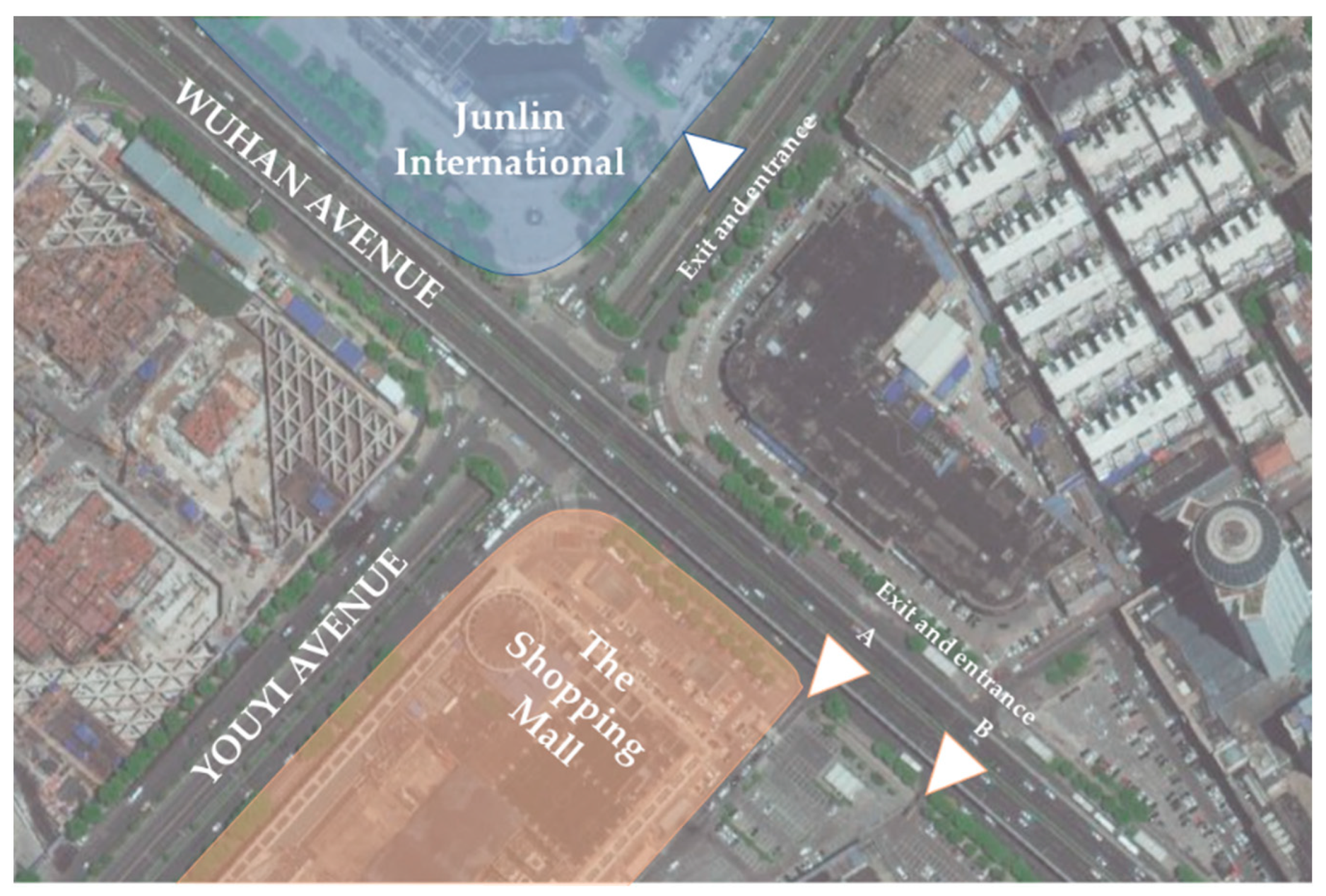


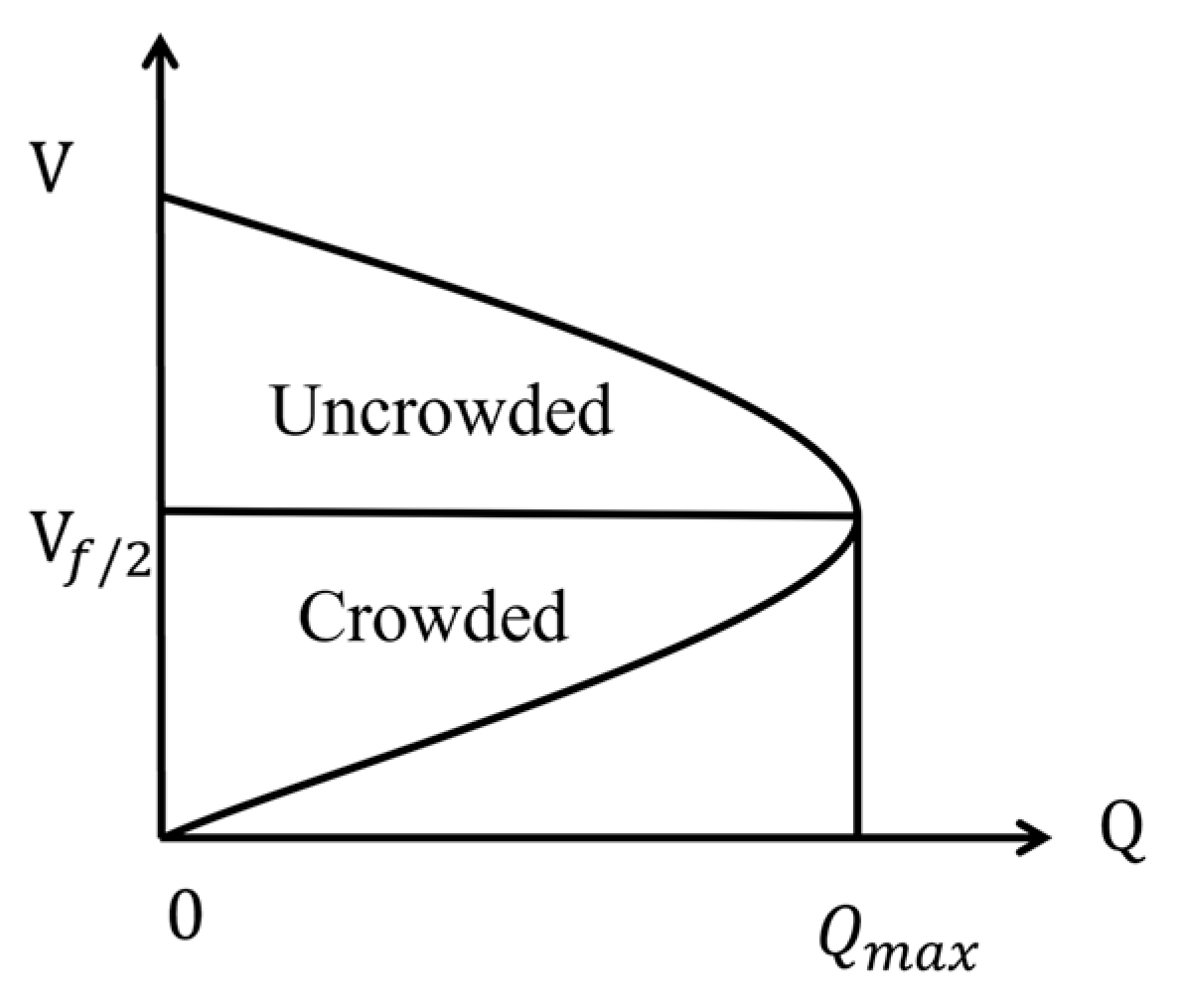


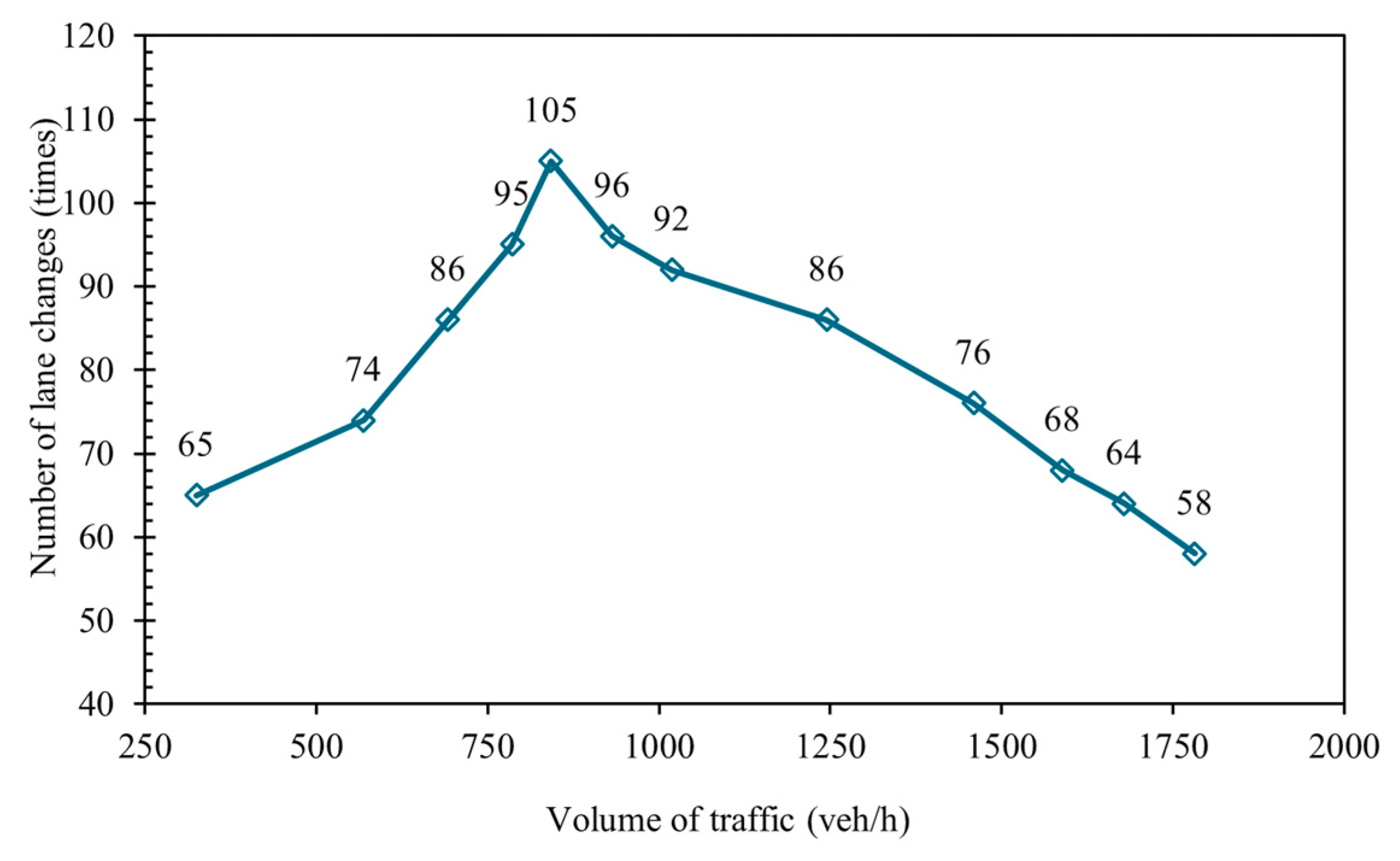
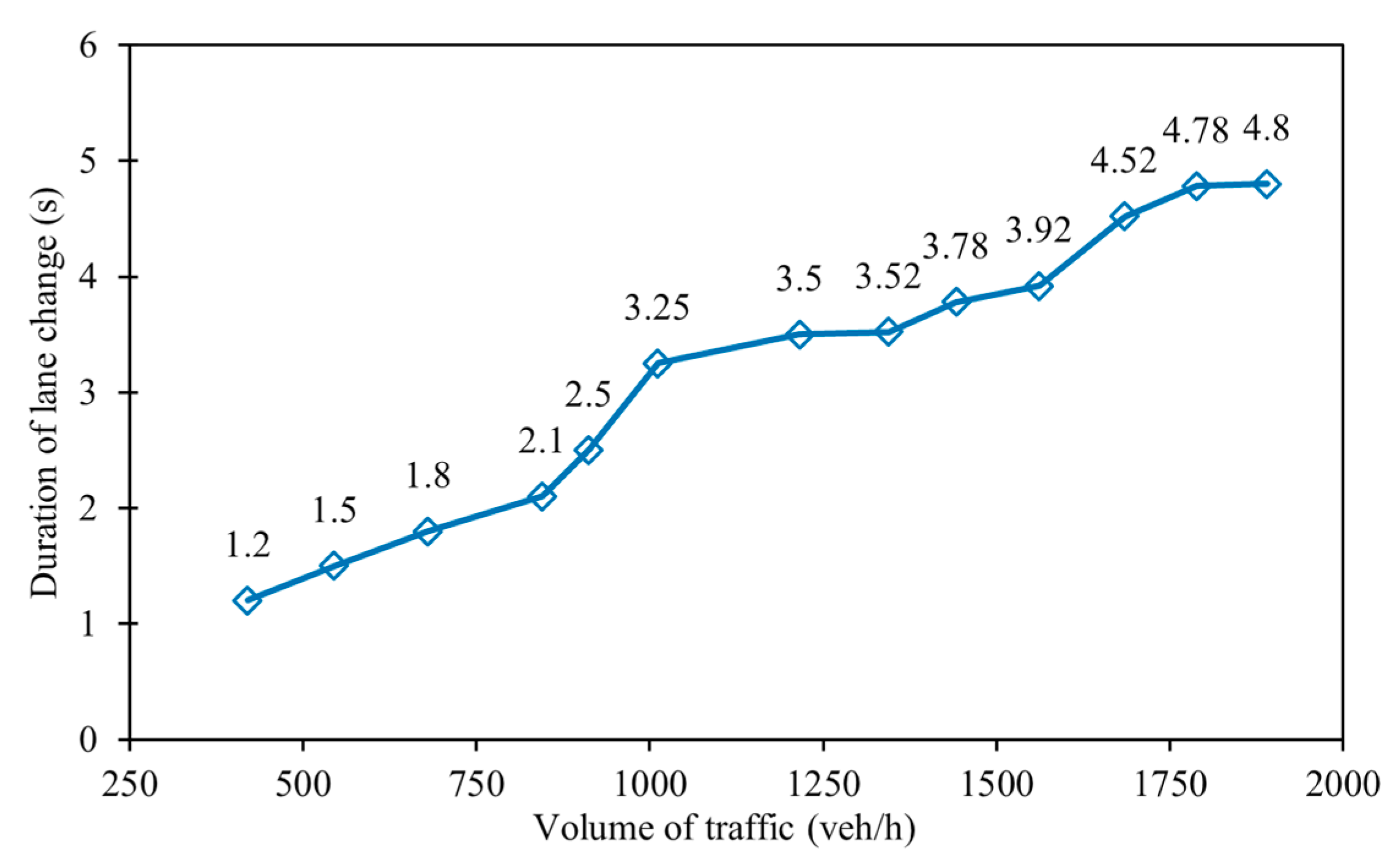
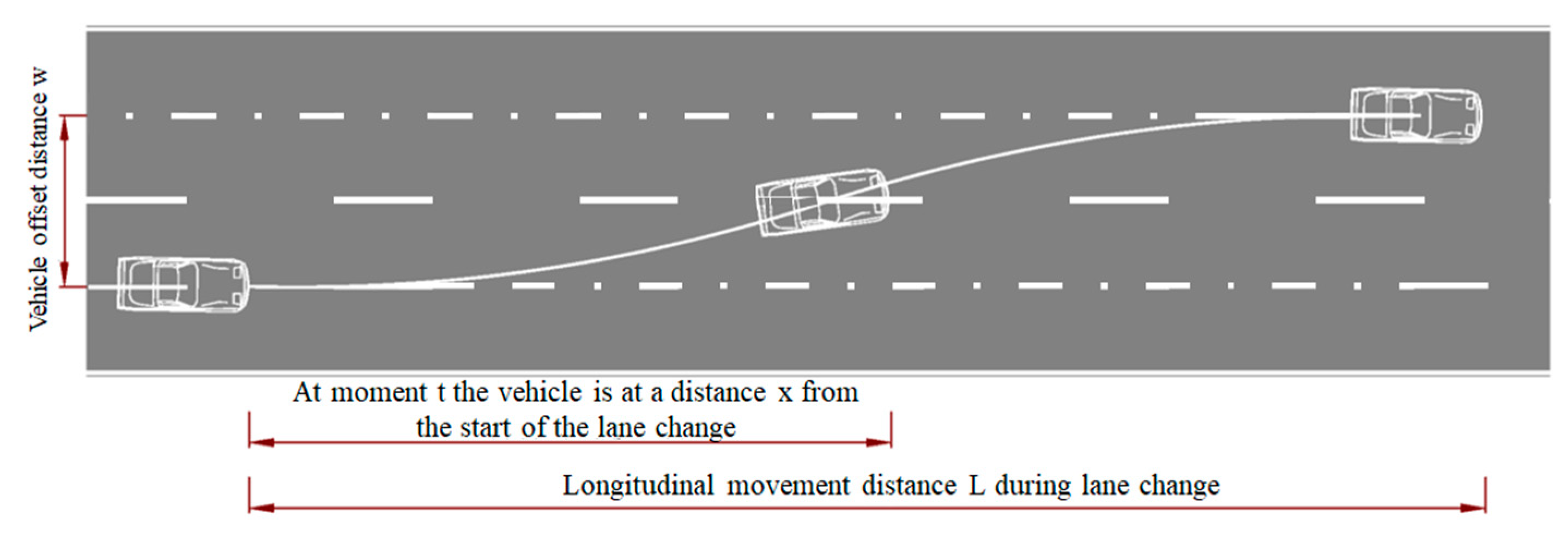

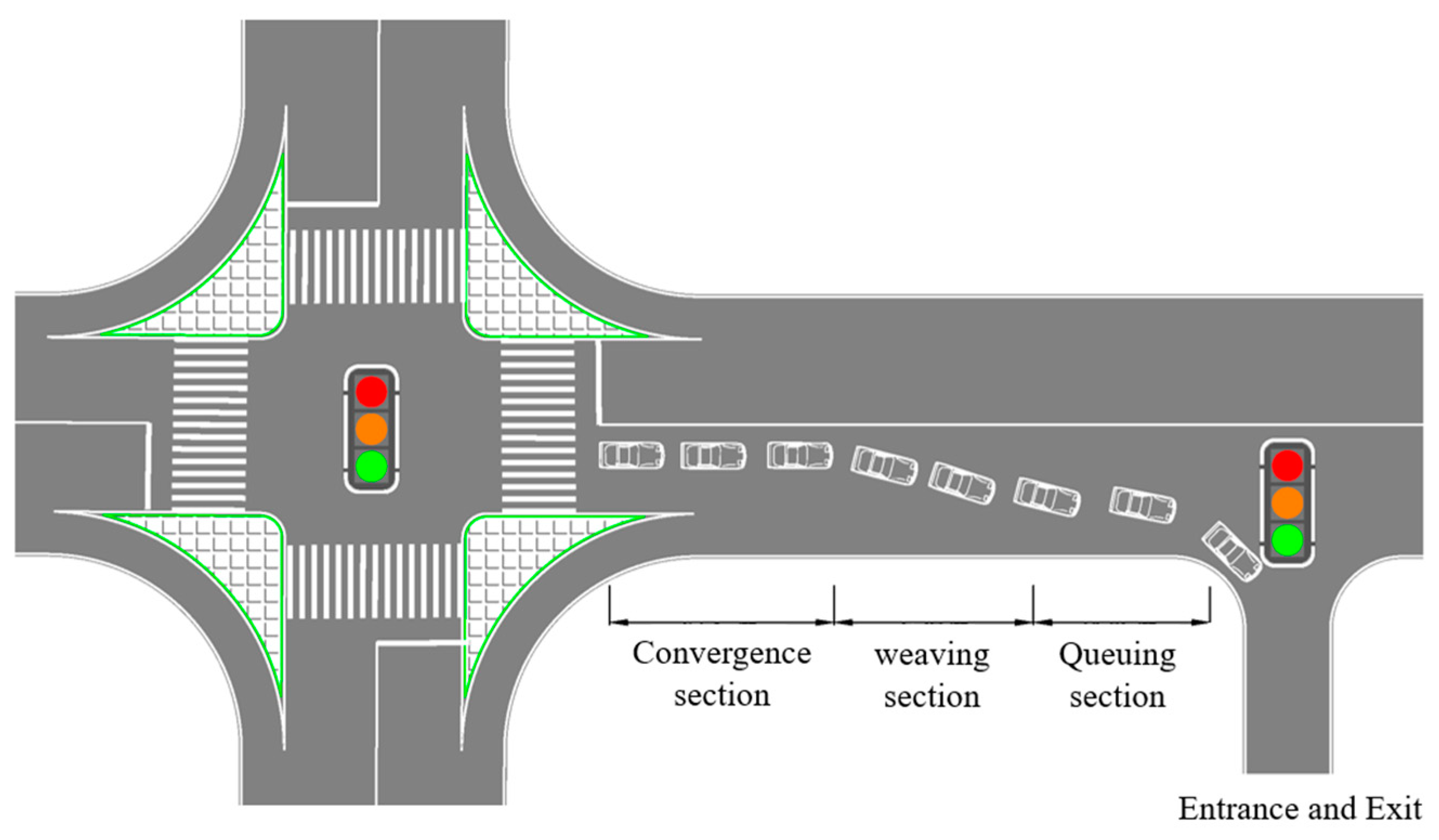
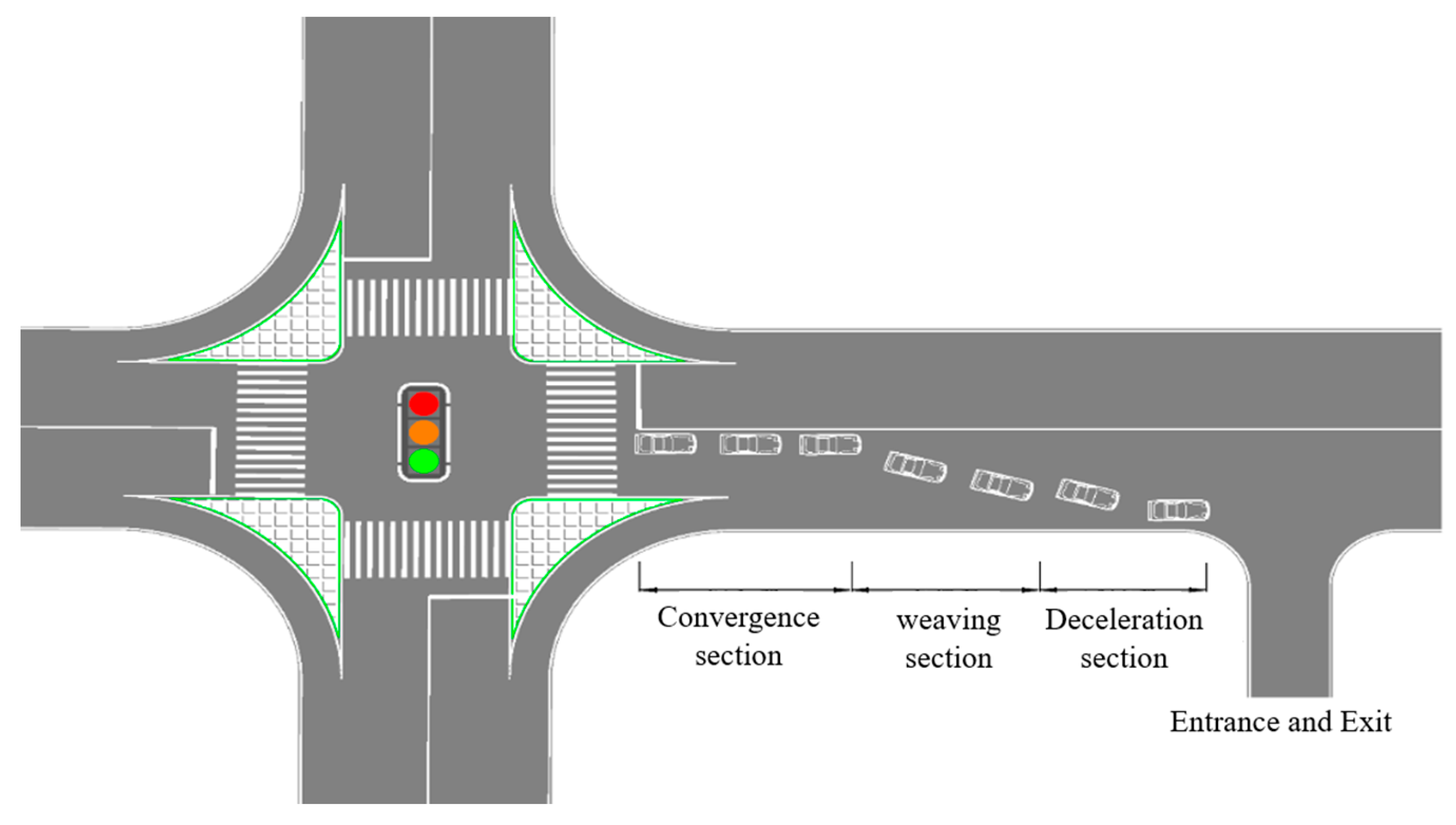


| Time | East Entrance (pcu) | South Entrance (pcu) | West Entrance (pcu) | North Entrance (pcu) | ||||||||
|---|---|---|---|---|---|---|---|---|---|---|---|---|
| L | S | R | L | S | R | L | S | R | L | S | R | |
| 17:00~17:15 | 91 | 126 | 62 | 69 | 83 | 50 | 52 | 293 | 14 | 20 | 139 | 47 |
| 17:15~17:30 | 106 | 122 | 47 | 50 | 91 | 39 | 140 | 351 | 22 | 32 | 155 | 39 |
| 17:30~17:45 | 126 | 204 | 57 | 55 | 89 | 41 | 114 | 284 | 17 | 52 | 160 | 45 |
| 17:45~18:00 | 142 | 191 | 75 | 50 | 111 | 56 | 122 | 324 | 32 | 35 | 147 | 58 |
| 18:00~18:15 | 107 | 194 | 42 | 68 | 99 | 50 | 119 | 320 | 16 | 59 | 214 | 53 |
| 18:15~18:30 | 74 | 197 | 32 | 58 | 81 | 55 | 161 | 336 | 23 | 55 | 225 | 56 |
| 18:30~18:45 | 100 | 228 | 33 | 53 | 67 | 42 | 119 | 356 | 21 | 33 | 183 | 39 |
| 18:45~19:00 | 91 | 149 | 41 | 73 | 103 | 38 | 94 | 290 | 23 | 65 | 210 | 35 |
| Design Speed (km/h) | Number of Lanes | Model Value (m) | Recommended Value (m) |
|---|---|---|---|
| 40 | 2 | 154.45 | 160 |
| 3 | 179.62 | 180 | |
| 50 | 3 | 207.31 | 210 |
| 4 | 232.82 | 240 |
| Design Speed (km/h) | Number of Lanes | Model Value (m) | Recommended Value (m) |
|---|---|---|---|
| 40 | 2 | 144.56 | 150 |
| 3 | 166.47 | 170 | |
| 50 | 3 | 196.24 | 200 |
| 4 | 214.56 | 220 |
| Design Speed (km/h) | Number of Lanes | Model Value (m) | Recommended Value (m) |
|---|---|---|---|
| 40 | 2 | 124.56 | 130 |
| 3 | 146.47 | 150 | |
| 50 | 3 | 176.24 | 180 |
| 4 | 194.56 | 200 |
| Design Speed (km/h) | Model Value (m) | Recommended Value (m) |
|---|---|---|
| 40 | 112.45 | 120 |
| 50 | 139.72 | 140 |
| Parameter | Parameter Value |
|---|---|
| Entrance lanes number at the intersection | 4 |
| Entrance lanes number at the entrance/exit | 1 |
| Width of main road lane | 3.75 |
| Width of entrance lane at the entrance/exit | 3.5 |
| Current length of entrance/exit located upstream of intersection (m) | 76 |
| Calculated length of the entrance/exit upstream of the intersection in the model (m) | 200 |
| Current length of entrance/exit located downstream of intersection (m) | 95 |
| Calculated length of the entrance/exit downstream of the intersection in the model (m) | 220 |
| Type | Direction | Current Length | Model Calculated Length | ||
|---|---|---|---|---|---|
| Vehicle Speed | Queuing Delay | Vehicle Speed | Queuing Delay | ||
| Entrance/Exit | Drive in | 37.93 | 16.14 | 39.42 | 4.82 |
| Drive out | 28.10 | 29.26 | 32.58 | 20.71 | |
| Entrance Road | North left | 33.71 | 69.11 | 33.57 | 44.17 |
| North straight | 39.01 | 54.24 | 42.83 | 42.32 | |
| North right | 46.07 | 42.20 | 47.07 | 34.40 | |
| Type | Direction | Current Length | Model Calculated Length | ||
|---|---|---|---|---|---|
| Travel Time(s) | Vehicles Number | Travel Time(s) | Vehicles Number | ||
| Entrance/Exit | Drive in | 25.43 | 38 | 13.75 | 39 |
| Drive out | 53.76 | 79 | 41.17 | 87 | |
| Entrance Road | North Entrance | 48.27 | 112 | 31.06 | 159 |
| Type | Direction | Current Length | Model Calculated Length |
|---|---|---|---|
| Delay Time (s) | Delay Time (s) | ||
| Entrance/Exit | Drive in | 18.73 | 7.08 |
| Drive out | 46.94 | 34.86 | |
| Entrance Road | North Entrance | 41.44 | 24.27 |
| Type | Direction | Current Length | Model Calculated Length |
|---|---|---|---|
| Average Queue Length (m) | Average Queue Length (m) | ||
| Entrance/Exit | Drive in | 67.22 | 39.85 |
| Drive out | 85.96 | 62.59 | |
| Entrance Road | North Entrance | 179.71 | 162.54 |
| Type | Direction | Current Length | Model Calculated Length | ||
|---|---|---|---|---|---|
| Vehicle Speed | Queuing Delay | Vehicle Speed | Queuing Delay | ||
| Entrance/Exit | Drive in | 18.13 | 14.45 | 24.97 | 8.86 |
| Drive out | 25.56 | 0.24 | 32.68 | 0.00 | |
| Entrance Road | West Exit 1 | 37.11 | 24.52 | 45.13 | 18.12 |
| West Exit 2 | 31.23 | 32.72 | 42.18 | 25.33 | |
| West Exit 3 | 29.23 | 25.69 | 41.97 | 15.04 | |
| West Exit 4 | 26.82 | 16.13 | 38.46 | 14.65 | |
| Type | Direction | Current Length | Model Calculated Length | ||
|---|---|---|---|---|---|
| Travel Time (s) | Vehicles Number | Travel Time (s) | Vehicles Number | ||
| Entrance/Exit | Drive in | 20.56 | 83 | 16.67 | 96 |
| Drive out | 12.94 | 69 | 8.23 | 78 | |
| Exit Road | West Exit | 18.79 | 236 | 14.67 | 342 |
| Type | Direction | Current Length | Model Calculated Length |
|---|---|---|---|
| Delay Time (s) | Delay Time (s) | ||
| Entrance/Exit | Drive in | 12.34 | 8.68 |
| Drive out | 0.98 | 0.26 | |
| Exit Road | West Exit | 11.82 | 8.72 |
| Type | Direction | Current Length | Model Calculated Length |
|---|---|---|---|
| Average Queue Length (m) | Average Queue Length (m) | ||
| Entrance/Exit | Drive in | 27.76 | 12.38 |
| Drive out | 15.22 | 6.49 | |
| Exit Road | West Exit | 85.97 | 67.52 |
Disclaimer/Publisher’s Note: The statements, opinions and data contained in all publications are solely those of the individual author(s) and contributor(s) and not of MDPI and/or the editor(s). MDPI and/or the editor(s) disclaim responsibility for any injury to people or property resulting from any ideas, methods, instructions or products referred to in the content. |
© 2023 by the authors. Licensee MDPI, Basel, Switzerland. This article is an open access article distributed under the terms and conditions of the Creative Commons Attribution (CC BY) license (https://creativecommons.org/licenses/by/4.0/).
Share and Cite
Xu, F.; Xu, W.; Zhang, X.; Wang, Y.; Wang, F. Analysis of Traffic Characteristics and Distance Optimization Design between Entrances and Exits of Urban Construction Projects and Adjacent Planar Intersections. Sustainability 2023, 15, 8656. https://doi.org/10.3390/su15118656
Xu F, Xu W, Zhang X, Wang Y, Wang F. Analysis of Traffic Characteristics and Distance Optimization Design between Entrances and Exits of Urban Construction Projects and Adjacent Planar Intersections. Sustainability. 2023; 15(11):8656. https://doi.org/10.3390/su15118656
Chicago/Turabian StyleXu, Feng, Weidi Xu, Xiaona Zhang, Yin Wang, and Fu Wang. 2023. "Analysis of Traffic Characteristics and Distance Optimization Design between Entrances and Exits of Urban Construction Projects and Adjacent Planar Intersections" Sustainability 15, no. 11: 8656. https://doi.org/10.3390/su15118656
APA StyleXu, F., Xu, W., Zhang, X., Wang, Y., & Wang, F. (2023). Analysis of Traffic Characteristics and Distance Optimization Design between Entrances and Exits of Urban Construction Projects and Adjacent Planar Intersections. Sustainability, 15(11), 8656. https://doi.org/10.3390/su15118656





